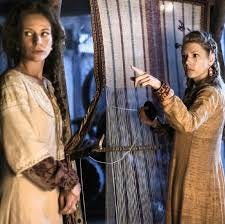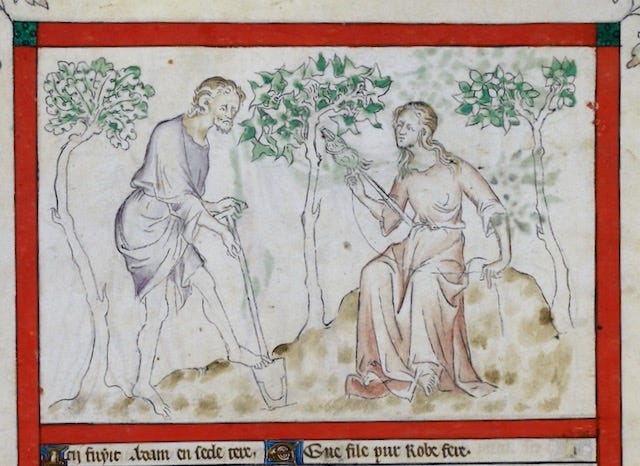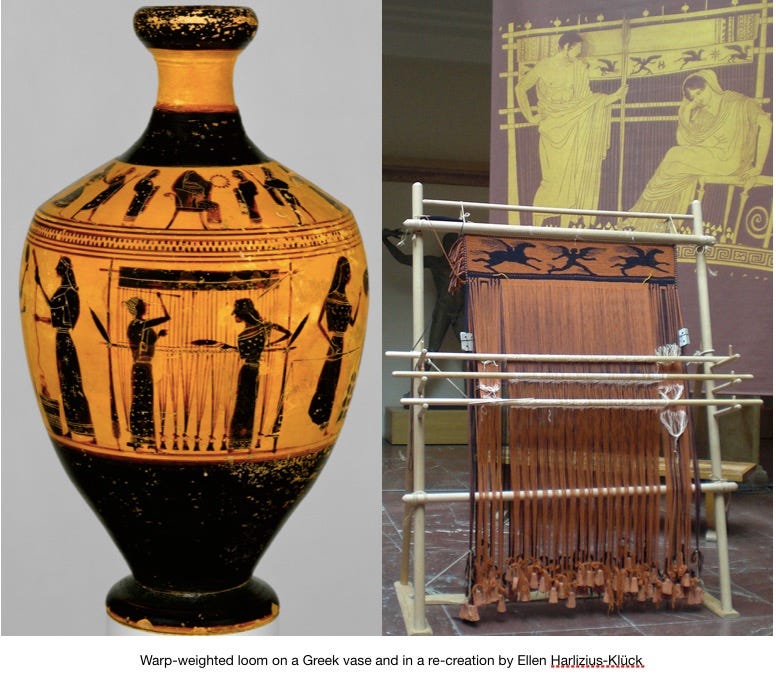From the Archives: Women and Men Are Like the Threads of a Woven Fabric
The historical achievements and experiences of women and men are like the intertwined warp and weft threads of a woven fabric. Remove either and you have only a bunch of string.
This article originally appeared in The New York Times on March 26, 2021. The lead reflects one of my frustrations: the separation of human history into male and female bins, where the male bin is the normal one and the female one gets special attention. The separation makes no logical sense. Unlike, say, American history or black history or Chinese history, women’s history isn’t the story of a people marked by a distinctive culture. Neither does it focus on a specialized area of endeavor like military history or art history or on a group of disciplinary tools and questions like economic history. Women’s history is—or should be—inextricable from human history. It is global phenomenon with many manifestations. It is only highlighted in March—and in academia—because for so long it was ignored. But men’s history and women’s history aren’t separate phenomena.
We are all descended from both women and men, culturally as well as biologically. So why do we celebrate Women’s History Month separately in March?
The historical achievements and experiences of women and men are like the intertwined warp and weft threads of a woven fabric. Remove either and you have only a bunch of string. Exploring the past experiences of women is valuable not because it weaves a new and separate historical fabric but because it restores strands that have gone missing.
Nowhere is this more obvious than in the history of one of humanity’s most important and influential technologies: textiles. Despite the vital roles played by men from the ancient wool trade to the invention of nylon, we tend to regard fabrics as feminine — and as frivolous.
Textiles have always been central to women’s lives and to the gendered division of household labor. “When Adam delved and Eve span, who then was the gentleman?” is an Old English saying. “Men till, women weave,” is the Chinese version. Like much of material culture, textiles have only drawn serious attention from historians and archaeologists in recent decades, in part because of the influence of female scholars.

Consider the Vikings. Popular feminist retellings like the History Channel’s fictional saga Vikings emphasize the role of women as warriors and chieftains. But they barely hint at how crucial women’s work was to the ships that carried these warriors to distant shores.
One of the central characters in Vikings is an ingenious shipbuilder. But his ships apparently get their sails off the rack. The fabric is just there, like the textiles we take for granted in our 21st-century lives. The women who prepared the wool, spun it into thread, wove the fabric and sewed the sails have vanished.
In reality, from start to finish, it took longer to make a Viking sail than to build a Viking ship. So precious was a sail that one of the Icelandic sagas records how a hero wept when his was stolen. Simply spinning wool into enough thread to weave a single sail required more than a year’s work, the equivalent of about 385 eight-hour days. King Canute, who ruled a North Sea empire in the 11th century, had a fleet comprising about a million square meters of sailcloth. For the spinning alone, those sails represented the equivalent of 10,000 work years.
Ignoring textiles writes women’s work out of history. And as the British archaeologist and historian Mary Harlow has warned, it blinds scholars to some of the most important economic, political and organizational challenges facing premodern societies. Textiles are vital to both private and public life. They’re clothes and home furnishings, tents and bandages, sacks and sails. Textiles were among the earliest goods traded over long distances. The Roman Army consumed tons of cloth. To keep their soldiers clothed, Chinese emperors required textiles as taxes.
“Building a fleet required longterm planning as woven sails required large amounts of raw material and time to produce,” Dr. Harlow wrote in a 2016 article. “The raw materials needed to be bred, pastured, shorn or grown, harvested and processed before they reached the spinners. Textile production for both domestic and wider needs demanded time and planning.” Spinning and weaving the wool for a single toga, she calculates, would have taken a Roman matron 1,000 to 1,200 hours.
Picturing historical women as producers requires a change of attitude. Even today, after decades of feminist influence, we too often assume that making important things is a male domain. Women stereotypically decorate and consume. They engage with people. They don’t manufacture essential goods.
Yet from the Renaissance until the 19th century, European art represented the idea of “industry” not with smokestacks but with spinning women. Everyone understood that their never-ending labor was essential. It took at least 20 spinners to keep a single loom supplied. “The spinners never stand still for want of work; they always have it if they please; but weavers are sometimes idle for want of yarn,” the agronomist and travel writer Arthur Young, who toured northern England in 1768, wrote.
Shortly thereafter, the spinning machines of the Industrial Revolution liberated women from their spindles and distaffs, beginning the centuries-long process that raised even the world’s poorest people to living standards our ancestors could not have imagined. But that “great enrichment” had an unfortunate side effect. Textile abundance erased our memories of women’s historic contributions to one of humanity’s most important endeavors. It turned industry into entertainment. “In the West,” Dr. Harlow wrote, “the production of textiles has moved from being a fundamental, indeed essential, part of the industrial economy to a predominantly female craft activity.”
For evidence of that profound amnesia we need look no further than the leather-clad Amazons of Hollywood’s Wonder Woman movies. They live in a world where the only textiles are patternless indicators of inferior spectator status.
In ancient Greece, by contrast, weaving was one of the culture’s defining practices, celebrated in ritual and art. Twenty-seven passages in Homer refer to it, including the famous story of Penelope warding off her suitors by weaving and unweaving the funeral cloth she is making for Laertes. Plato’s Statesman analogizes the ideal ruler to a weaver, uniting courageous and moderate citizens as the loom joins the strong warp and soft weft.
In the Wonder Woman movies’ supposedly feminist mythology, one deity is strikingly absent. She is Athena, the giver of ships and of looms, the “weaver” of plans with Odysseus, the clever goddess of useful craft. The Greeks called her domain “techne,” a word that shares a root with both technology and textile.
When we slight her gifts, we miss women’s vital contributions to the richly interwoven fabric of civilization.
Upcoming Book Talks
March 23, 10:00 a.m. Textile Arts Council, San Francisco Fine Arts Museums, Koret Auditorium, de Young museum, Golden Gate Park, San Francisco. Tickets $5 (free with membership). Information here.
March 23, 2:30 p.m. San Jose Museum of Quilts and Textiles. Tickets $15. Information here.
April 2, noon, Wabash College. Information here.
April 15, details coming, Clemson University.






Fascinating, as usual. It did make me think of a notable literary character who was a weaver and male--Silas Marner.
Though many who have never spent time in rural places don’t realize it, contemporary farm and ranch life remains a strongly egalitarian enterprise, much as it has been through time.